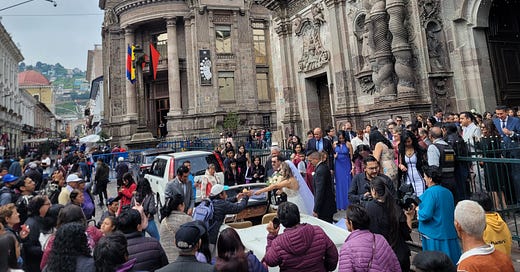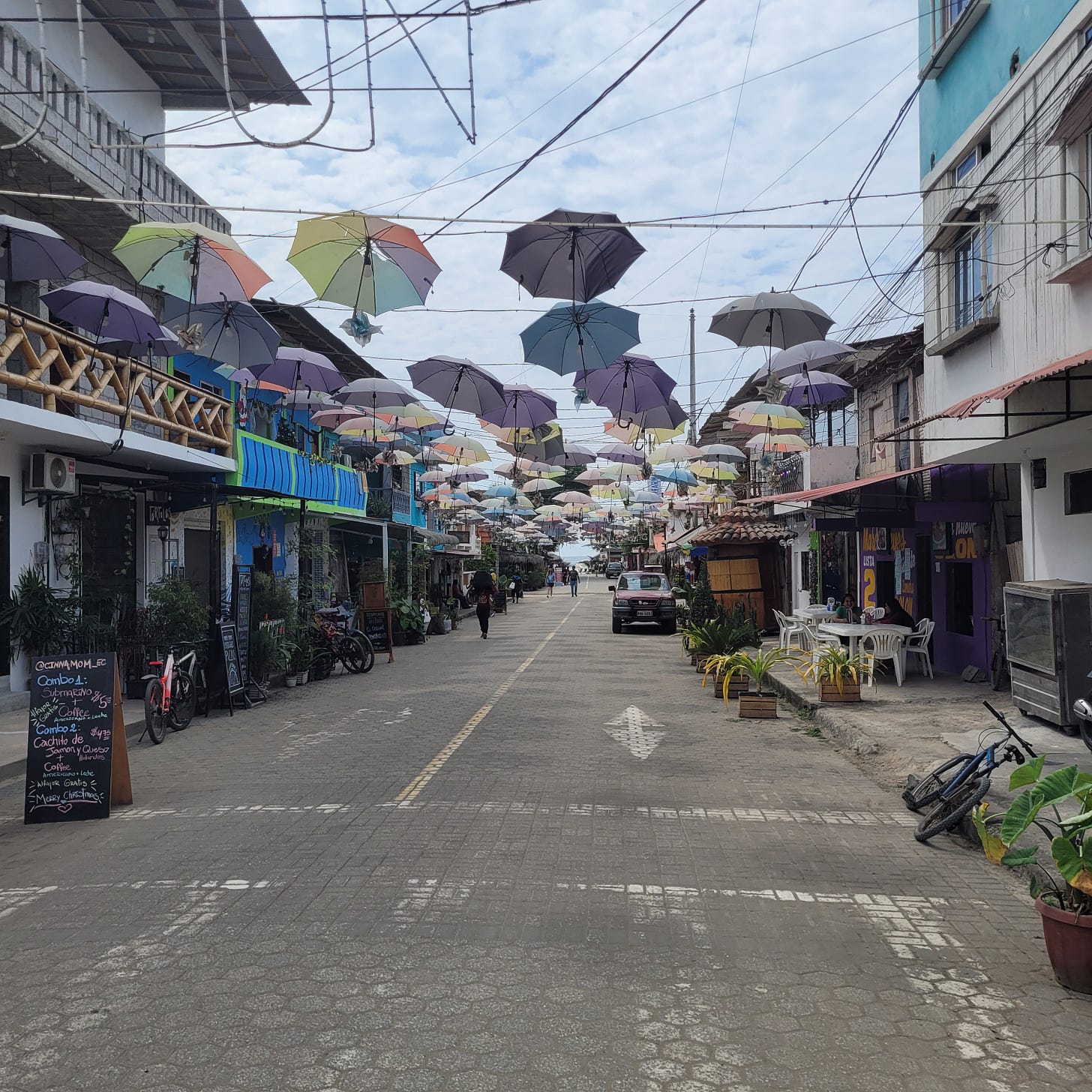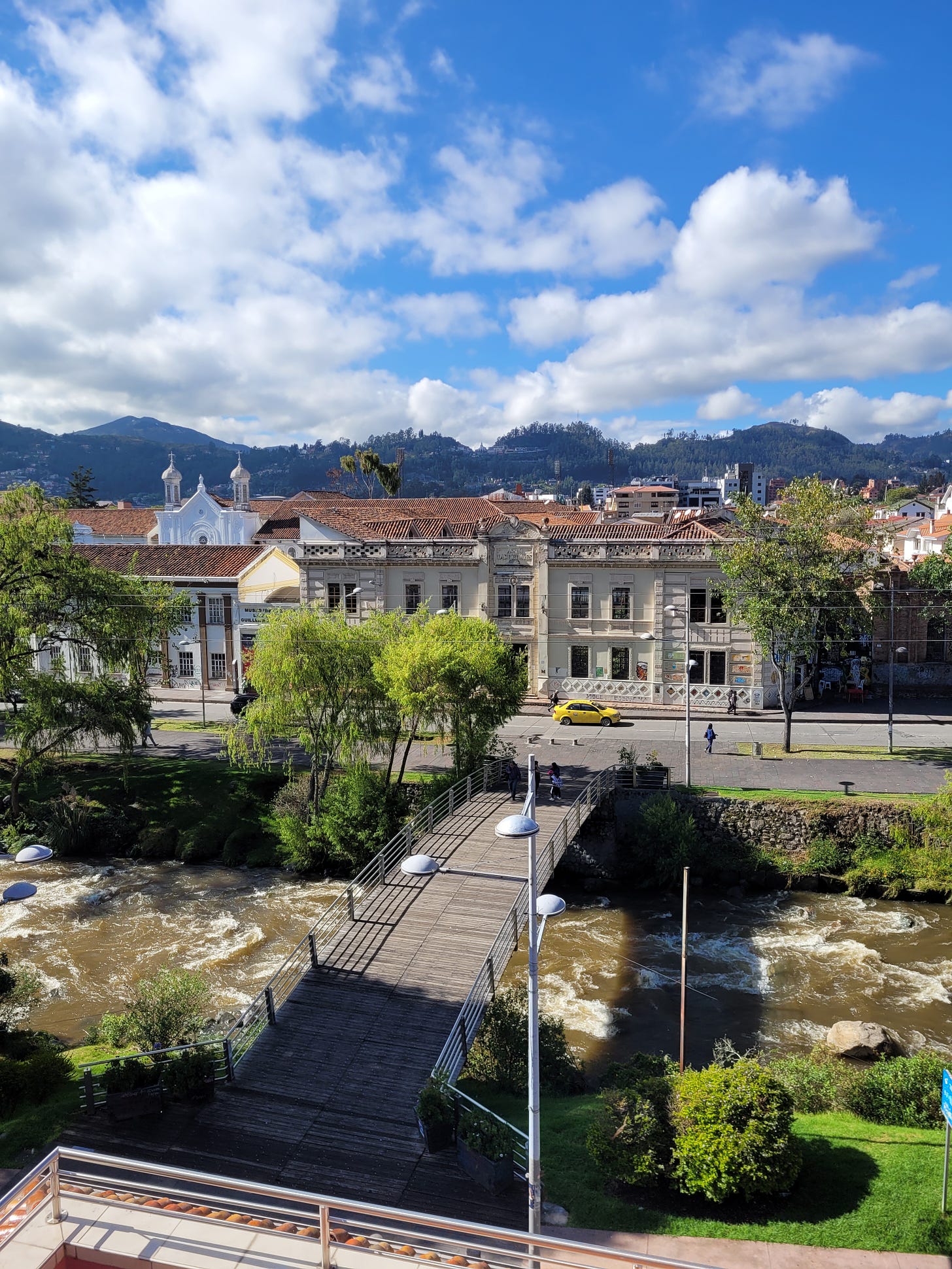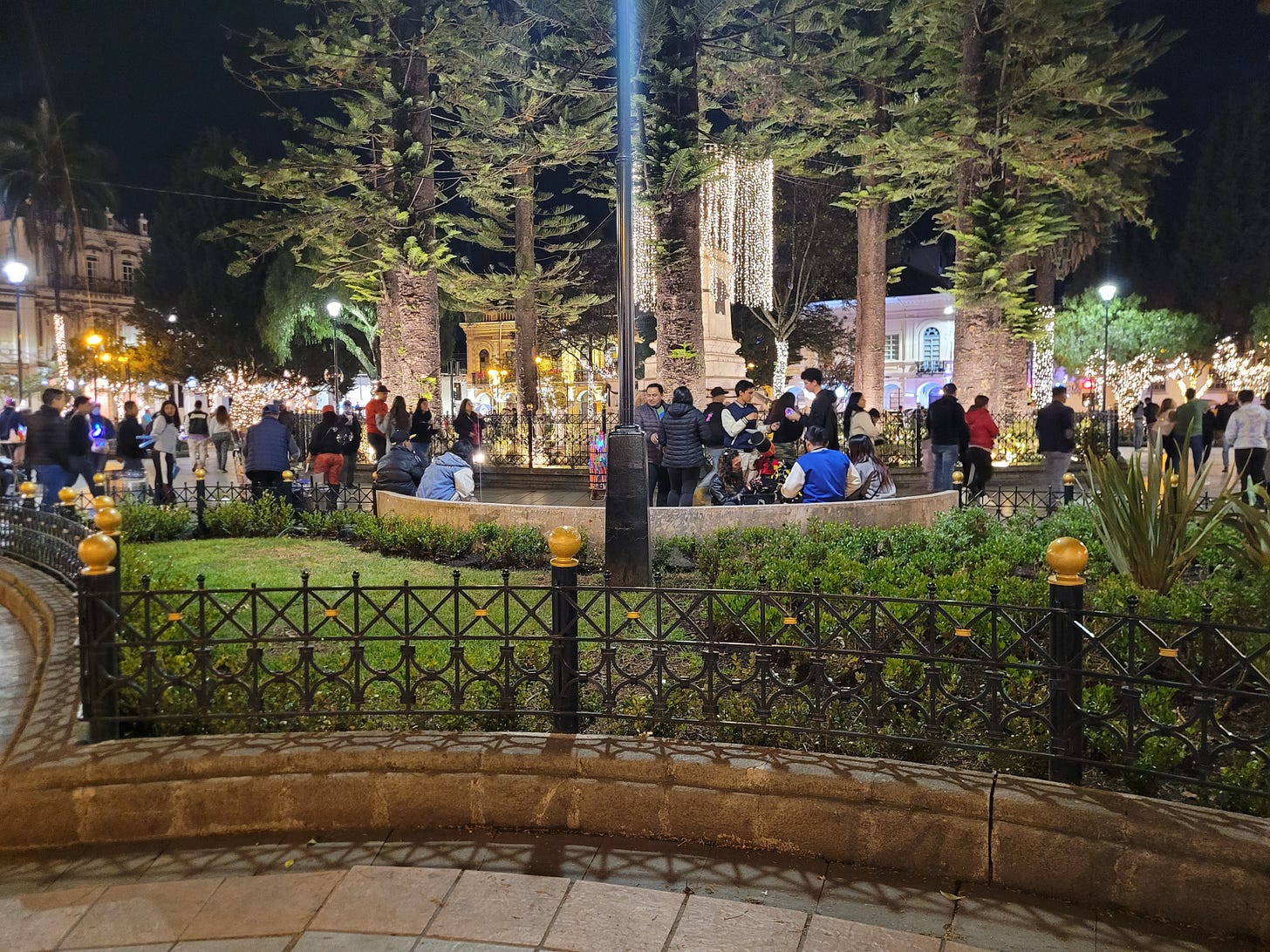A Reflection About Honeymooning in Ecuador (and Traveling in General)
Every place has problems and nowhere is "safe" but we go out to face the world anyway
For readers who may not know, I went on a 20-day honeymoon in Ecuador in December of 2023. The trip’s objective was to climb in Cojitambo and Columnas of Tangán and surf in Olón. Oh, and celebrate our matrimony. The following is a reflection I had after getting home.
Four days after my wife Whitney and I got home from our honeymoon in Ecuador, the country devolved into violence. What spurred the violence? The prison escape of a high-profile drug lord named El Fito, described by Ecuadorian authorities as “Ecudaor’s most wanted prisoner.”
Fito’s disappearance sent shockwaves through the country, criminal justice system, and drug gangs. The following day, riots broke out across six different jails, and guards were taken hostage. In addition to the prison riots, several bombs were detonated throughout the country. Two days after Fito’s escape, masked gang members took over a TV broadcast station, taking hostages and threatening to kill the TV staff, which was broadcast on live TV.
In response, Ecuadorian President Noboa declared a state of emergency, deployed military units throughout many major cities across the country, set a curfew for civilians, and enacted a war against the drug gangs, now classified as terrorist organizations.
Although the string of events following Fito’s escape got the most press attention, making it seem like the problem came out of nowhere, the reality is that Ecuador had been struggling with violence for much longer. In the last five years, the murder rate in Ecuador has quadrupled. In 2023 alone, about 8,000 people fell victim to violent deaths, including presidential candidate Fernando Villavicencio in August, making 2023 the most violent year in Ecuador’s history.
While Ecuador is struggling to control its own problems related to drugs, gangs, and gang violence, the situation has unfortunately been wildly exacerbated by Mexican and Colombian drug cartels. In particular, drug cartels are competing over Ecuadorian territory.
The reason? The country of Ecuador is sandwiched between two massive cocaine-producing countries–Colombia and Peru– and, therefore, can function as a lucrative shipping port. Specifically, cartels are harnessing Ecuador's banana exportation as a vehicle for their products.
Did we know violent death rates in Ecuador were increasing? Or that the country was about to reach a boiling point? Honestly– no. We did not know the full extent of what was going on in the country. I think if the locals I was communicating with told us themselves that it wasn’t a good time to visit, then we would have reconsidered. But nothing we learned from the folks currently living in Ecuador raised enough red flags for us to plan our trip somewhere else.
Planning Our Trip Amidst Ecuador’s Growing Violence Problem
Before we left, we received a few warnings about the potential dangers in the country. Throughout the planning stages, I was in communication with various Ecuadorians who shared their perspectives on the matter. Most notably, professional Ecuadorian rock climber and guidebook author Felip Proaño, one of our more helpful people leading to the trip, talked about the presence of narco-traffickers along the Pacific coast. He shared advice about visiting the coast and how to avoid trouble. All of which seemed pretty “textbook” for traveling abroad.
Of course, our parents also gave us nervous warnings. As good parents do, they looked into our destination and wondered if it would be safe. My mom, in particular, cited recent travel advisories from the US Department of State. We consulted the travel advisories in detail. Fortunately, our trip itinerary was not going to take us anywhere near the locations in Ecuador labeled as problematic by the U.S. government.
While not ignoring the advice from locals or rolling our eyes at the protective tendencies of our parents, we took all of the warnings with a grain of salt and carried forward with our trip.
The rock climbing looked too good to cancel. Not to mention, the El Nino swells would be hitting the coast perfectly upon our arrival.
Our previous Travel Backgrounds Prepared Us to Travel in Places with Suspected Issues
Most importantly, we stuck with our honeymoon in Ecuador because we are experienced travelers, especially in Latin America. As a kid, I vacationed with my family in Mexico for many summers. During my undergraduate years, I lived in Costa Rica for six months, during which time I visited Nicaragua and Panama. Later, I lived in Peru for two years while serving in the Peace Corps. Whitney visited multiple times during my stint in Peru; on one such trip, we traveled to Colombia together. In February of last year, I went to a wedding in Uruguay.
Thanks to all my time in North, South, and Central America, I’ve learned invaluable travel lessons that have given me the confidence to travel throughout the continent. I know how to make conservative travel decisions, like only traveling by day, concealing valuables, and avoiding certain neighborhoods. Plus, I speak the language fluently. My Spanish fluency allows me to navigate cities without looking lost, eavesdrop on conversations, ask for help, interpret complex and stressful situations, and verbally defend myself if I need to.
Not to mention, I’ve been navigating unsafe places, people, and situations while traveling to and from different cities just by growing up in the United States.
The U.S. is Not Much Different From Ecuador
When I respond to the question “de donde eres” or “where are you from” I sometimes say, los estados jodidos instead of los estados unidos. In Spanish, I’m making a joke, a play on words. Los estados jodidos is like saying “the fucked states.” Pardon my French. It sounds a lot like the correct response, which is los estados unidos, or “the United States.”
I say this because it always gets a laugh. But also because we’ve got plenty of our own problems, and we’re not much different than Ecuador. What I mean is that people come to the U.S. and have to make many of the same travel decisions as Whitney and I did in Ecuador.
When people travel to the United States for their honeymoons or family vacations, they have a lot of doubts about how safe our country is. When tourists visit cities in the U.S., whether that’s the final destination or if they are passing through to get to some other “safer” place, they also wonder if they’ll be assaulted or pickpocketed in the urban environment.
For example, many international climbers coming to climb in the Gunks go in and out of New York City. In 2022, there were over 125,000 major felony offenses, including murder, rape, robbery, assault, burglary, grand larceny, and grand larceny of a motor vehicle. Any of which could have involved visiting tourists.
If a climber wants to go to visit international travel destinations like Yosemite or Joshua Tree National Park, California, they have to navigate major cities like San Francisco, Sacramento, or Los Angeles. In California, violent crimes have increased by 5.7% from 2021 to 2022. In cities like SF, Sacramento, and LA, crime rates also increased in 2022.
Urban cities aside, the rural parts of our country also have issues. This matters because to go climbing, you often spend time in rural settings. For example, one of my favorite sport climbing areas is in “the middle of nowhere” in Kentucky.
Some individuals from rural communities in North America have nationalist and xenophobic tendencies and are particularly unfriendly toward outsiders. In particular, climbers of color may deal with racism, while climbers from the lesbian, gay, bisexual, transgender, queer, questioning, intersex, and asexual community (LGBTQIA+) may also experience stigmatization while spending time in rural America.
To add a little more fuel to the fire, in December 2023, the BBC reported that there were 630 mass shootings across the United States. That’s almost two shootings a day. Mind-boggling.
From my travels and from talking with friends from other countries who ask about the shootings, I’ve learned the reality of mass shootings occurring in the U.S. is particularly jarring and terrifying for outsiders considering visiting.
The Comparison May Not Be Perfect…
… But you have to admit, it does make you second guess how safe the U.S. really is.
In addition, I hope it helps you realize natural ethnocentric tendencies to instinctually (and blindly) assume one country is safer or better than another without considering the facts.
We all do it. I fall into this trap myself, and I repeatedly have to recalibrate my perspective. Fortunately for me, my travels help me do that. Whenever I have the privilege of exploring a new place in South America, I come back completely inspired. Despite all the troubles a certain country in South America might have, my travels consistently allow me to interact with beautiful natural landscapes, friendly people, welcoming cities, wonderful food, inspiring culture, and intriguing history.
Fortunately, the same can be said for the United States. I’ve traveled all over the U.S. I am often in awe of the people and places I’ve seen along the way. It’s just we have problems like other countries. Nowhere is perfect.









Beautiful photos and a great example of xenophobia and nationalistic tendencies. I recall a Geography class about Place, Power, and Culture that explored these topics in depth. I felt safer in parts of CDMX than I do in parts of Denver. I'll also be stealing that excellent piece of slang!
Good piece, my boy! It's really crazy to some of us outsiders to think about how naive some us citizens seem to be when it comes to grasp their own reality, which is just as imperfect and complicated as anyone else's. It's also so weird to see how people just carry on with their lives amidst coups, dictatorship, violence, daily mass shootings or whatever may be. The narco problem is getting big in many places, it's very sad. And it's also interesting to acknowledge that all of our issues are intertwined, with governments, drug dealers and companies, and all you can imagine being trafficked all over the world while normal people fall victim to the violence.
The pictures took me back to Ecuador, i remember sitting in the exact same places where you took them and having the exact same views. Isn't that crazy? I mean, it's not, but it's fun to think about it.